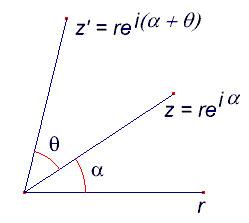
 |
The Klein View of Geometry |
The euclidean group
Let E denote the euclidean plane.
Definition 1
An isometry is a transformation of E which preserves (euclidean) distance.
The set of all isometries is the euclidean group E(2).
Obvious examples are
By the Cosine Rule, the size of the angles of a triangle are determined by the lengths of its sides,
so isometries preserve the size of angles.
Definition 2
An isometry which preserves size and sense of angles is direct,
One which reverses the sense of all angles is indirect.
The set of direct isometries forms the subgroup E+(2) of E(2).
Translations and rotations are direct, while relections are indirect.
It is by no means clear that each isometry is either direct or indirect. We shall get this from Theorem 1 below.
Lemma 1
Suppose that t is an isometry which fixes the points O(0,0) and X(1,0). Then either
Theorem E1
The group E(2) is generated by reflections.
Each reflection is indirect, so if an isometry is the composite of an even number of reflections, it is direct,
if it is the product of an odd number, it is indirect. Thus, we have the
| Corollary Each isometry is either direct or indirect.
To give an algebraic description of E(2), it is convenient to regard E as the complex plane C.
We can now describe the elements of E(2). |
 |
Theorem E2
If t is a direct isometry, then t(z) = az + b,
where a, b are in C, and |a| = 1.
If t is an indirect isometry, then t(z) = az* + b,
where a, b are in C, and |a| = 1.
| Although Theorem E2 has a very simple form and proof, we often want to use coordinates. Suppose that a, b are in C with |a| = 1. Then a = cos(q) + isin(q), for some real q. Let b = c + id, with c,d real. |

|
| Suppose that t is the direct isometry t(z) = az + b. If we look at real and imaginary parts of t(x +iy), then we see that t maps the point (x,y) to the point (x.cos(q) - y.sin(q) +c, x.sin(q) + y.cos(q) + d).
Notice that this can be written in matrix form as x maps to Aqx + b, |
 |
| Now suppose that t is the indirect isometry t(z) = az* + b. A similar calculation shows that t maps (x,y) to (x.cos(q) + y.sin(q) +c, x.sin(q) - y.cos(q) + d).
Notice that this can be written in matrix form as x maps to Bqx + b, |

|
The matrices Aq and Bq
comprise the group of orthogonal group of 2×2 real matrices.
It is not difficult to check that any matrix C which is orthogonal
(i.e. which satisfies CTC = I) has one of these forms.
We now have a matrix version of E(2)
Theorem E3
E(2) = {t(x) = Ax + b, where A is a real orthogonal 2×2 matrix, and b a real vector}.
The direct isometries are those with det(A)=1.
| Main Klein Page |
|